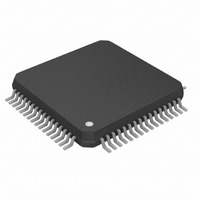DS26504L+ Maxim Integrated Products, DS26504L+ Datasheet - Page 83

DS26504L+
Manufacturer Part Number
DS26504L+
Description
IC T1/E1/J1 64KCC ELEMENT 64LQFP
Manufacturer
Maxim Integrated Products
Datasheet
1.DS26504L.pdf
(129 pages)
Specifications of DS26504L+
Function
BITS Element
Interface
64KCC, E1, T1
Number Of Circuits
1
Voltage - Supply
3.14 V ~ 3.47 V
Current - Supply
150mA
Operating Temperature
0°C ~ 70°C
Mounting Type
Surface Mount
Package / Case
64-LQFP
Includes
*
Lead Free Status / RoHS Status
Lead free / RoHS Compliant
Power (watts)
-
DS26504 T1/E1/J1/64KCC BITS Element
The transmit line drive has two modes of operation: fixed gain or automatic gain. In the fixed gain mode,
the transmitter outputs a fixed current into the network load to achieve a nominal pulse amplitude. In the
automatic gain mode, the transmitter adjusts its output level to compensate for slight variances in the
network load. See the Transmit Line Build-Out Control (TLBC) register for details.
13.3.1 Transmit Short-Circuit Detector/Limiter
The DS26504 has an automatic short-circuit limiter that limits the source current to approximately 50mA
(RMS) on the network side of the transformer in E1 modes of operations and 70mA (RMS) on the
network side of the transformer in T1 modes of operation. These values are approximate and are not
guaranteed by production testing. This feature can be disabled by setting the SCLD bit (LIC2.1) = 1.
TCLE (SR1.2) provides a real-time indication of when the current limiter is activated. If the current
limiter is disabled, TCLE will indicate that a short-circuit condition exists. Status Register SR1.2 provides
a latched version of the information, which can be used to activate an interrupt when enable via the IMR1
register. When set low, the TPD bit (LIC1.0) will power-down the transmit line driver and three-state the
TTIP and TRING pins.
13.3.2 Transmit Open-Circuit Detector
The DS26504 can also detect when the TTIP or TRING outputs are open circuited. TOCD (SR1.1) will
provide a real-time indication of when an open circuit is detected. SR1 provides a latched version of the
information (SR1.1), which can be used to activate an interrupt when enabled via the IMR1 register. The
functionality of these bits is not guaranteed by production testing.
13.3.3 Transmit BPV Error Insertion
When IBPV (LIC2.5) is transitioned from a zero to a one, the device waits for the next occurrence of
three consecutive ones to insert a BPV. IBPV must be cleared and set again for another BPV error
insertion.
13.3.4 Transmit G.703 Section 13 Synchronization Signal (E1 Mode)
The DS26504 can transmit the 2.048MHz square-wave synchronization clock. To transmit the 2.048MHz
clock, when in E1 mode, set the mode configuration bits in the Mode Configuration Register (MCREG).
13.4 MCLK Pre-Scaler
N
N
A 2.048MHz x 2
(where N = 0 to 3), 1.544MHz x 2
(where N = 0 to 3), or 12.8MHz (available in
CPU interface mode only) clock must be applied to MCLK. A pre-scaler (divide by 2, 4, or 8) and PLLs
are selected to product an internal 2.048MHz or 1.544MHz clock. ITU specification G.703 requires an
accuracy of ±50ppm for both T1 and E1. TR62411 and ANSI specs require an accuracy of ±32ppm for
T1 interfaces. A pre-scaler divides the 16.384MHz, 12.8MHz, 8.192MHz, or 4.096MHz clock down to
2.048MHz. An on-board PLL for the jitter attenuator converts the 2.048MHz clock to a 1.544MHz rate
for T1 applications. Setting JACKS0 (LIC2.3) to logic 0 bypasses this PLL.
13.5 Jitter Attenuator
The DS26504’s jitter attenuator can be set to a depth of either 32 bits or 128 bits via the JABDS bit
(LIC1.2). The 128-bit mode is used in applications where large excursions of wander are expected. The
32-bit mode is used in delay-sensitive applications. The characteristics of the attenuation are shown in
Figure 13-10
and
Figure
13-11. The jitter attenuator can be placed in either the receive path or the
transmit path by appropriately setting or clearing the JAS bit (LIC1.3). The jitter attenuator can also be
disabled (in effect, removed) by setting the DJA bit (LIC1.1). Either the recovered clock from the
83 of 129











